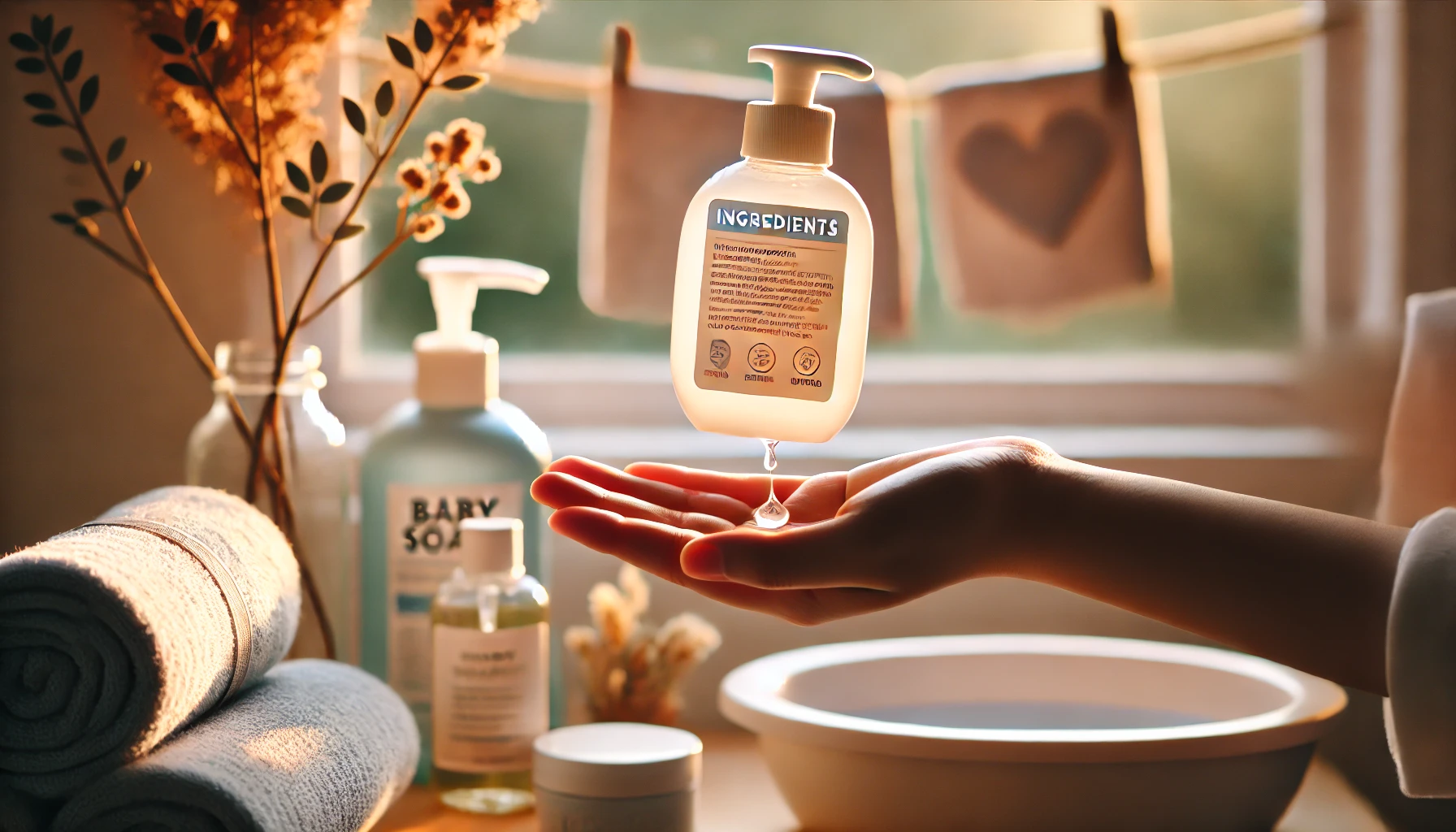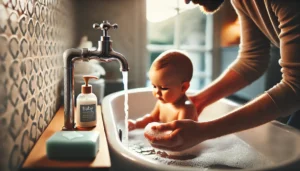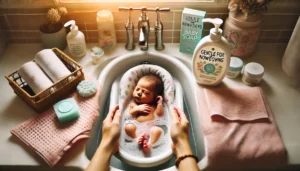Have you ever looked at a baby soap label and wondered, What are all these ingredients? One of the most common – yet confusing – words you’ll find is surfactants. These are powerful cleaning agents found in nearly every soap, including those made for newborns.
But here’s the catch: not all surfactants are created equal. Some are mild and baby-safe, while others may irritate sensitive skin. As a parent, knowing the difference is essential.
In this blog, I’ll guide you through what surfactants are, why they matter, and how to choose the safest baby soap for your little one. Let’s make sense of what’s really touching your baby’s skin.
What Are Surfactants?
Surfactants, short for “surface-active agents,” are the key ingredients that make soap soap. They help water mix with oil and dirt so that it can be rinsed away. In simple terms, they’re what create the foam and bubbles that we associate with cleanliness.
Without surfactants, soap wouldn’t be able to lift dirt or remove oils from the skin. They reduce surface tension between different substances, allowing water to spread and clean more effectively.
In baby soaps, surfactants play the same basic role—but they need to be much milder. A baby’s skin is thinner, more delicate, and more prone to irritation, which means that harsh surfactants found in regular soaps can be too aggressive.
Understanding which surfactants are used and how gentle they are is the first step in choosing the right product for your baby’s daily care.
Why Surfactants Are Used in Baby Soaps
Surfactants are essential in baby soaps because they handle the most basic—but crucial—job: cleansing. Babies may not roll around in mud, but their skin still accumulates oils, milk residues, drool, and even traces of diaper leaks. All of that needs to be gently washed away.
So, what makes surfactants so important in this process?
They lift dirt, sweat, and oils from the skin, break them down, and help water rinse them away. Even a tear-free, mild baby soap can’t do its job without the right surfactant working behind the scenes.
But here’s the tricky part: while surfactants clean well, the wrong kind can strip the skin’s natural oils, leaving it dry, itchy, or irritated. For babies with eczema or ultra-sensitive skin, this can be especially problematic.
That’s why many baby soaps are carefully formulated to include non-stripping, ultra-mild surfactants—ingredients that clean without damaging the skin barrier. Choosing the right soap means finding one that strikes the perfect balance between cleansing power and gentleness.
Types of Surfactants
Surfactants come in different types, and not all of them are created equal—especially when it comes to baby skincare. Understanding the categories can help you recognize which ones are safe and which ones to avoid.
There are four main types of surfactants, each with different properties:
1. Anionic Surfactants
These are the most common and most powerful cleaners. They create a lot of foam and are great at removing dirt and oil. However, they can also be harsh on sensitive skin, especially for babies.
Example: Sodium Lauryl Sulfate (SLS), Sodium Laureth Sulfate (SLES)
2. Cationic Surfactants
These are mainly used in conditioners and not commonly found in baby soaps. They bind to skin and hair but can be irritating if not formulated correctly.
Example: Behentrimonium chloride
3. Non-Ionic Surfactants
These are considered mild and skin-friendly. They don’t produce much foam, but they cleanse gently—perfect for babies.
Example: Decyl Glucoside, Lauryl Glucoside
4. Amphoteric Surfactants
These are very mild and often used in baby shampoos and soaps. They’re usually paired with other gentle surfactants to reduce irritation.
Example: Cocamidopropyl Betaine, Disodium Cocoamphodiacetate
When selecting baby soaps, it’s important to look for non-ionic or amphoteric surfactants. These are much gentler and help protect the baby’s delicate skin barrier while still doing their job.
Safe vs Harsh Surfactants
When it comes to your baby’s skin, the line between safe and harsh surfactants really matters. A gentle soap can leave your baby’s skin soft and protected, while a harsh one can cause dryness, redness, or irritation—even after a single use. Let’s break it down so it’s easy to understand.
Harsh Surfactants — What to Avoid
Some surfactants are just too strong for a baby’s delicate skin. They’re often used in adult products because they foam well and clean aggressively, but that same power can strip away natural oils and disrupt the skin barrier in babies.
Here are a few you’ll want to avoid:
- Sodium Lauryl Sulfate (SLS): Strong and drying. Commonly linked to skin irritation.
- Sodium Laureth Sulfate (SLES): A little gentler than SLS but still not ideal for infants.
- Ammonium Lauryl Sulfate: Often used in shampoos, but not recommended for babies.
- Alcohol-based surfactants: These can quickly dry out the skin.
If any of these appear near the top of the ingredients list, it’s usually a sign the soap might be too harsh for your baby.
Safe Surfactants — What to Look For
Thankfully, many brands are now formulating baby soaps with milder, more skin-friendly surfactants. These clean gently without stripping the skin’s natural moisture.
Also read about the pros and cons of using one baby soap brand long-term.
Here are the safe ones to look for:
- Decyl Glucoside
- Cocamidopropyl Betaine
- Lauryl Glucoside
- Sodium Cocoyl Isethionate
- Disodium Cocoamphodiacetate
These are often derived from coconut oil or sugar, making them more natural and far gentler on sensitive skin.
Quick Parent Tip: If your baby’s skin feels tight or dry after a bath, it might be time to check the label. Sometimes switching to a product with gentler surfactants can instantly improve skin comfort and reduce flare-ups.
Common Surfactants Found in Baby Products
Ever read the ingredients on your baby’s soap bottle and feel completely lost? You’re not alone. Baby skincare brands often use long, scientific names that sound intimidating—even when they’re perfectly safe. So let’s break down the most common surfactants you’ll find in baby soaps, body washes, and shampoos.
These are the names you’re likely to see on labels—and what they actually mean.
Cocamidopropyl Betaine
A coconut-derived surfactant that helps baby soaps foam gently. It’s widely used because it’s mild and works well in combination with other cleansing agents. Some babies with very sensitive skin might react to it, though that’s rare.
Decyl Glucoside
This is a super gentle, non-ionic surfactant made from sugar and coconut. It’s ideal for babies with eczema, dry skin, or sensitivities. You’ll often find it in organic or hypoallergenic baby washes.
Sodium Cocoyl Isethionate
Also known as “baby foam,” this one is a favorite in syndet bars and creamy cleansers. It creates a rich, soft lather without drying out the skin. Derived from coconut, it’s considered very mild and effective.
Disodium Laureth Sulfosuccinate
Despite the long, intimidating name, this is one of the gentlest surfactants used in baby products. It’s much milder than traditional sulfates and often used in tear-free formulas.
Sodium Lauryl Sulfate (SLS)
Still found in some baby products, especially cheaper ones—but not recommended. It’s a powerful cleanser but can be too harsh for your baby’s delicate skin. If your baby has dry patches, rashes, or redness, check the label for this one.
Lauryl Glucoside
Mild and non-irritating, this sugar-based surfactant is excellent for newborns. It’s commonly found in natural baby skincare lines and works well with sensitive skin.
Understanding these names helps you move beyond marketing terms like “gentle” or “natural.” It lets you truly know what’s touching your baby’s skin.
Are Natural Surfactants a Better Option?
It’s a question every thoughtful parent eventually asks: Should I switch to natural surfactants? The short answer? Often, yes. But let’s look deeper so you can decide what’s right for your baby.
Natural surfactants are usually plant-derived and less processed. They’re made from sources like coconut oil, palm kernel oil, sugar, or corn. Unlike some synthetic options, they’re not just gentler—they’re also less likely to cause allergies or irritation.
Natural doesn’t always mean better—but in the world of baby skincare, it’s usually a safer bet.
Why Parents Prefer Natural Surfactants
- Less irritating: They tend to respect the skin’s natural barrier.
- Eco-friendly: Many are biodegradable and sustainably sourced.
- Minimal additives: Often free from unnecessary perfumes, dyes, or preservatives.
- Ideal for sensitive skin: Especially useful for babies with eczema or allergies.
Some of the best-known natural surfactants include:
- Decyl Glucoside (from corn glucose)
- Lauryl Glucoside (from coconut oil and sugar)
- Sodium Cocoyl Glutamate (from coconut oil and fermented sugar)
These are commonly found in premium or organic baby brands. They create a soft lather, cleanse gently, and rinse off easily without leaving behind residues.
Are They Always the Best Choice?
Natural surfactants aren’t perfect. They may lather less, and some baby soaps with them are a bit pricier. But when you weigh that against fewer skin issues, happier bath times, and less worry—many parents find it’s a worthwhile investment.
Eco-conscious parents may also want to explore baby soap packaging’s environmental impact.
How to Read Baby Soap Labels
Reading a baby soap label shouldn’t feel like decoding a science experiment—but let’s be honest, sometimes it does. If you’ve ever flipped over a bottle and felt overwhelmed by the list of ingredients, you’re not alone. The good news? Once you know what to look for—and what to avoid—you can shop with confidence.
Here’s a simple step-by-step way to understand what those labels are really saying.
Step 1: Start with the First Five Ingredients
Ingredients are listed in descending order by quantity. So, the first 4–5 ingredients make up most of the product. If you see harsh surfactants like SLS or alcohol in the top five, it’s a red flag. Look instead for gentle ingredients like Decyl Glucoside or Cocamidopropyl Betaine.
Step 2: Spot the Surfactants
Scan for the surfactants you now recognize. Safe ones to look for include:
- Decyl Glucoside
- Lauryl Glucoside
- Sodium Cocoyl Isethionate
- Disodium Cocoamphodiacetate
Avoid harsh ones like:
- Sodium Lauryl Sulfate (SLS)
- Ammonium Lauryl Sulfate
- Sodium Laureth Sulfate (SLES)
Step 3: Look for “Free From” Claims
Labels that say “Sulfate-Free,” “Tear-Free,” “Paraben-Free,” and “Fragrance-Free” can be helpful—but they’re not everything. Always double-check the ingredient list. A product might say “natural” on the front and still include irritating additives on the back.
Step 4: Check for Certifications
Badges like “Dermatologist Tested”, “Hypoallergenic”, or “EWG Verified” can indicate that a product has been evaluated for safety. They’re not foolproof, but they’re good indicators of better formulations.
Step 5: Don’t Be Fooled by Fragrance
Even natural-sounding labels like “lavender” or “chamomile” can be made from synthetic fragrances. If the ingredient list says “fragrance” or “parfum” without being marked as natural or essential oil-based, it might irritate sensitive skin.
Step 6: Simpler is Better
Fewer ingredients usually mean fewer chances of irritation. If a baby soap has a long list of hard-to-pronounce chemicals, put it back. Choose one with short, familiar ingredient names where possible.
Not sure which format is better? This bar vs liquid baby soap breakdown can help you decide.
Reading labels takes an extra minute—but it’s worth it for your baby’s skin comfort and safety.
Expert Tips for Choosing the Right Baby Soap
Choosing the right soap for your baby isn’t just about picking a nice-smelling bottle. It’s about protecting delicate skin, preventing irritation, and making bath time soothing—not stressful. As someone who’s tested, researched, and helped parents find gentle care solutions, here are the most practical, experience-backed tips to help you shop smart.
Tip #1: Prioritize Fragrance-Free Formulas
Babies don’t need fragrance to smell good—they’re naturally sweet! Synthetic fragrances are a leading cause of irritation and allergic reactions in infants. Even natural fragrances like essential oils can be too strong for newborns.
Look for: “Fragrance-Free” or “No added perfume” labels.
Tip #2: Go Sulfate-Free
Sulfates like SLS and SLES are effective cleansers, but too harsh for baby skin. They strip away natural oils and can lead to dryness, flakiness, or redness.
Safer surfactants to look for:
- Sodium Cocoyl Isethionate
- Decyl Glucoside
- Lauryl Glucoside
- Cocamidopropyl Betaine (if tolerated)
Tip #3: Choose pH-Balanced Products
Newborn skin has a naturally acidic pH that helps protect against bacteria and moisture loss. Soaps that are too alkaline can disrupt this balance.
Look for labels that mention “pH balanced”—especially important for babies with eczema or skin sensitivity.
Tip #4: Avoid “Tear-Free” Gimmicks (Unless Labeled Safely)
Not all “tear-free” claims are created equal. Some use numbing agents to reduce stinging rather than improving the formula’s gentleness.
Tip: Trust brands that are transparent about their ingredients and use safe surfactants for tear-free claims (like Disodium Laureth Sulfosuccinate).
Tip #5: Test First, Even with Gentle Brands
Every baby is different. Even if a soap is labeled safe or natural, do a patch test behind the ear or on the arm before full use—especially for newborns or babies with known sensitivities.
You might also want to read this guide on how to prevent diaper rashes effectively—another common skincare concern for babies.
Quick Parent Tip: If your baby’s skin looks dry, irritated, or red after a bath—switch the soap first. Most of the time, it’s the cleanser causing the trouble, not the water or towel.
If in doubt, here’s a quick guide on how to tell if baby soap is expired.
Conclusion
Your baby’s skin is more than just soft—it’s sensitive, absorbent, and developing. That’s why choosing the right surfactant in baby soap matters more than most parents realize. Harsh chemicals might clean well, but they can also strip moisture, trigger irritation, and disrupt your baby’s skin barrier.
By learning about surfactants, understanding label language, and knowing what to avoid, you’re taking a smart step toward safer, gentler skincare. Look for soaps that are sulfate-free, fragrance-free, and made with mild, natural surfactants like Decyl Glucoside or Sodium Cocoyl Isethionate. And always keep an eye on how your baby’s skin responds—because no label is more important than your little one’s comfort.
Looking for reliable options? Check out these best baby soaps and washes tested for safety and gentleness.
Want to go one step further? Bookmark this guide, share it with other parents, and explore trusted baby care products that prioritize safety without sacrificing quality.



